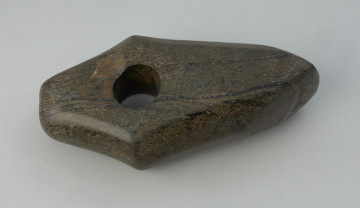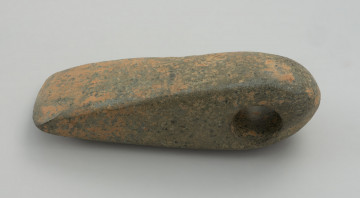
Stone axe
National Museum in Szczecin
Part of the collection: Stone Age
A double-edged axe, broken at the hole level for setting the handle, was found by accident in the area of the present Wały Chrobrego in Szczecin. The fort, named after the then commander of the local garrison, Prince Leopold von Anhalt-Dessau, was designed, along with the entire ring of fortifications of the Szczecin fortress Gerhard Cornelius von Walrave, a military engineer in the service of the Berlin Hohenzollerns. It was the first realisation of this architect, a precursor of the canon of 18th-century Prussian fortress-city fortifications, who also designed other buildings in Szczecin, including the Palace of the Parliament of the Pomeranian States - from 1827 adapted to house a museum (now the Museum of Regional Traditions of the National Museum in Szczecin). In 1873, a decision was taken to liquidate the Szczecin fortress and dismantle the fortifications. It was then, in 1874, that the first fragment of the axe excavated from the embankment of the rampart found its way to the Szczecin museum collection. The second part was not donated until 1891. Metal axes and stone axes with both ends symmetrically widened up and down, about ancient accounts and Greek mythology, are called labrys, and sometimes axes of Amazons - women warriors, for whom they were weapons and symbols of power. Only a few double-edged stone axes are known from West Pomerania. They are probably evidence of contact with the Nordic area in the last centuries of the 3rd and 2nd millennium BC. Different varieties of such forms were widespread in the Neolithic Funnel Beaker culture in northern Germany and southern Scandinavia, when younger structures of megalithic tombs, the so-called passage tombs, were constructed there. These axes are generally considered to be weapons and objects of prestige, and their prototypes are found in stone slashes or the oldest copper axes.
Krzysztof Kowalski
Author / creator
Dimensions
cały obiekt: height: 11.4 cm
Object type
axe, hatchet, blunt weapon
Technique
drilling, carving, smoothing
Material
stone
Origin / acquisition method
acquisition
Creation / finding place
Owner
National Museum in Szczecin
Identification number
Location / status

National Museum in Szczecin

National Museum in Szczecin

National Museum in Szczecin
DISCOVER this TOPIC
National Museum in Szczecin
DISCOVER this PATH
Educational path